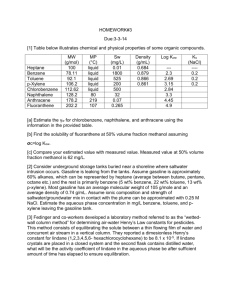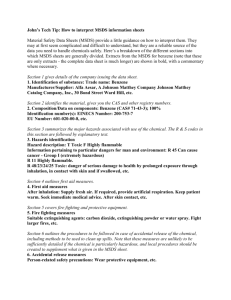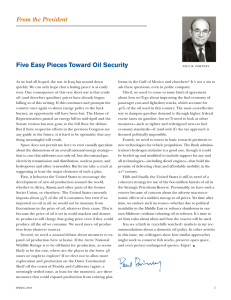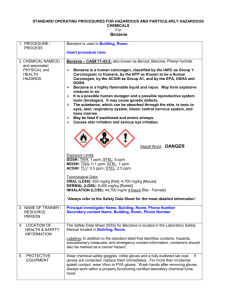Aviation Gasoline, 100 LL
advertisement
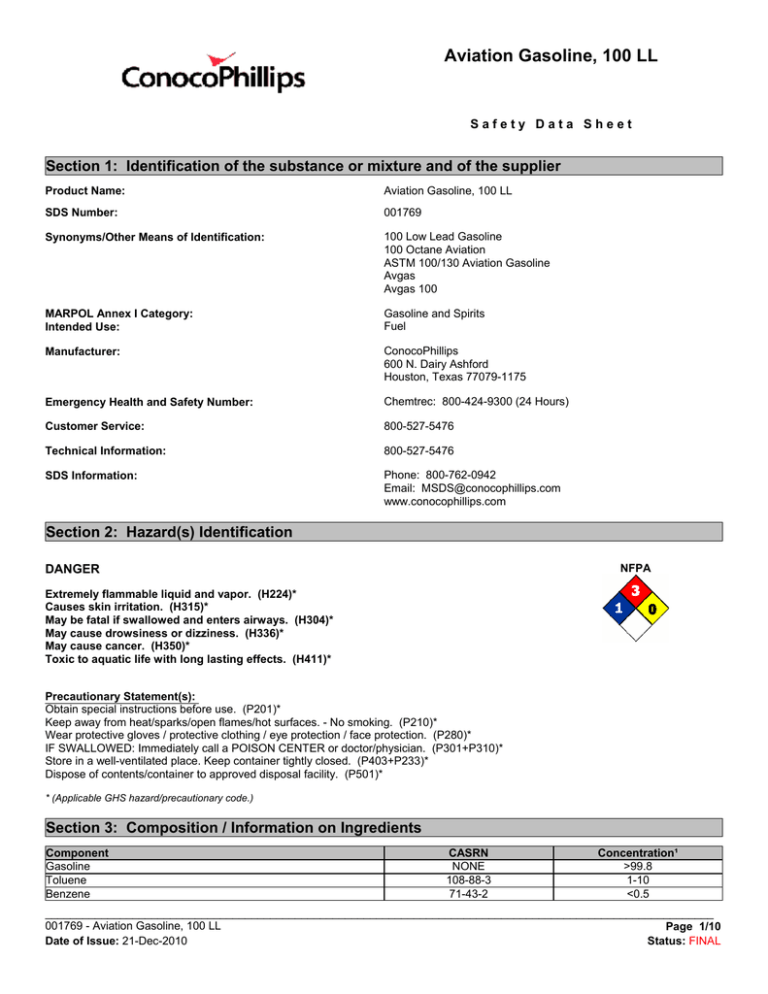
Aviation Gasoline, 100 LL Safety Data Sheet Section 1: Identification of the substance or mixture and of the supplier Product Name: Aviation Gasoline, 100 LL SDS Number: 001769 Synonyms/Other Means of Identification: 100 Low Lead Gasoline 100 Octane Aviation ASTM 100/130 Aviation Gasoline Avgas Avgas 100 MARPOL Annex I Category: Intended Use: Gasoline and Spirits Fuel Manufacturer: ConocoPhillips 600 N. Dairy Ashford Houston, Texas 77079-1175 Emergency Health and Safety Number: Chemtrec: 800-424-9300 (24 Hours) Customer Service: 800-527-5476 Technical Information: 800-527-5476 SDS Information: Phone: 800-762-0942 Email: MSDS@conocophillips.com www.conocophillips.com Section 2: Hazard(s) Identification NFPA DANGER Extremely flammable liquid and vapor. (H224)* Causes skin irritation. (H315)* May be fatal if swallowed and enters airways. (H304)* May cause drowsiness or dizziness. (H336)* May cause cancer. (H350)* Toxic to aquatic life with long lasting effects. (H411)* Precautionary Statement(s): Obtain special instructions before use. (P201)* Keep away from heat/sparks/open flames/hot surfaces. - No smoking. (P210)* Wear protective gloves / protective clothing / eye protection / face protection. (P280)* IF SWALLOWED: Immediately call a POISON CENTER or doctor/physician. (P301+P310)* Store in a well-ventilated place. Keep container tightly closed. (P403+P233)* Dispose of contents/container to approved disposal facility. (P501)* * (Applicable GHS hazard/precautionary code.) Section 3: Composition / Information on Ingredients Component Gasoline Toluene Benzene CASRN NONE 108-88-3 71-43-2 Concentration¹ >99.8 1-10 <0.5 ___________________________________________________________________________________________________________ 001769 - Aviation Gasoline, 100 LL Page 1/10 Date of Issue: 21-Dec-2010 Status: FINAL 001769 - Aviation Gasoline, 100 LL Page 2/10 Status: FINAL Date of Issue: 21-Dec-2010 ___________________________________________________________________________________________________________ Section 3: Composition / Information on Ingredients Tetraethyl Lead 78-00-2 0.13 Total Sulfur: < 0.1 wt% ¹ All concentrations are percent by weight unless ingredient is a gas. Gas concentrations are in percent by volume. Section 4: First Aid Measures Eye Contact: If irritation or redness develops from exposure, flush eyes with clean water. If symptoms persist, seek medical attention. Skin Contact: Remove contaminated shoes and clothing, and flush affected area(s) with large amounts of water. If skin surface is damaged, apply a clean dressing and seek medical attention. If skin surface is not damaged, cleanse affected area(s) thoroughly by washing with mild soap and water or a waterless hand cleaner. If irritation or redness develops, seek medical attention. Wash contaminated clothing before reuse. If product is injected into or under the skin, or into any part of the body, regardless of the appearance of the wound or its size, the individual should be evaluated immediately by a physician. (see Note to Physician) Inhalation (Breathing): If respiratory symptoms develop, move victim away from source of exposure and into fresh air in a position comfortable for breathing. If breathing is difficult, oxygen or artificial respiration should be administered by qualified personnel. If symptoms persist, seek medical attention. Ingestion (Swallowing): Aspiration hazard: Do not induce vomiting or give anything by mouth because this material can enter the lungs and cause severe lung damage. If victim is drowsy or unconscious and vomiting, place on the left side with the head down. If possible, do not leave victim unattended and observe closely for adequacy of breathing. Seek medical attention. Notes to Physician: Epinephrine and other sympathomimetic drugs may initiate cardiac arrhythmias in persons exposed to high concentrations of hydrocarbon solvents (e.g., in enclosed spaces or with deliberate abuse). The use of other drugs with less arrhythmogenic potential should be considered. If sympathomimetic drugs are administered, observe for the development of cardiac arrhythmias. When using high-pressure equipment, injection of product under the skin can occur. In this case , the casualty should be sent immediately to hospital. Do not wait for symptoms to develop. High-pressure hydrocarbon injection injuries may produce substantial necrosis of underlying tissue despite an innocuous appearing external wound. These injuries often require extensive emergency surgical debridement and all injuries should be evaluated by a specialist in order to assess the extent of injury. Early surgical treatment within the first few hours may significantly reduce the ultimate extent of injury. Federal regulations (29 CFR 1910.1028) specify medical surveillance programs for certain exposures to benzene above the action level or PEL (specified in Section (i)(1)(i) of the Standard). In addition, employees exposed in an emergency situation shall, as described in Section (i)(4)(i), provide a urine sample at the end of the shift for measurement of urine phenol. Medical Conditions Aggravated by Exposure: Conditions which may be aggravated by exposure include skin disorders. Exposure to high concentrations of this material may increase the sensitivity of the heart to certain drugs. Persons with pre-existing heart disorders may be more susceptible to this effect (see Section 4 - Note to Physicians). Section 5: Fire-Fighting Measures NFPA 704 Hazard Class Health: 1 Flammability: 3 Instability: 0 (0-Minimal, 1-Slight, 2-Moderate, 3-Serious, 4-Severe) Unusual Fire & Explosion Hazards: Extremely flammable. This material can be ignited by heat, sparks, flames, or other sources of ignition (e.g., static electricity, pilot lights, mechanical/electrical equipment, and electronic devices such as cell phones, computers, calculators, and pagers which have not been certified as intrinsically safe). Vapors may travel considerable distances to a source of ignition where they can ignite, flash back, or explode. May create vapor/air explosion hazard indoors, in confined spaces, outdoors, or in sewers. This product will float and can be reignited on surface water. Vapors are heavier than air and can accumulate in low areas. If container is not properly cooled, it can rupture in the heat of a fire. Extinguishing Media: Dry chemical, carbon dioxide, or foam is recommended. Water spray is recommended to cool or protect exposed materials or structures. Carbon dioxide can displace oxygen. Use caution when applying carbon dioxide in confined spaces. Simultaneous use of foam and water on the same surface is to be avoided as water destroys the foam. Water may be ineffective for extinguishment, unless used under favorable conditions by experienced fire fighters. 001769 - Aviation Gasoline, 100 LL Page 3/10 Date of Issue: 21-Dec-2010 Status: FINAL ___________________________________________________________________________________________________________ Fire Fighting Instructions: For fires beyond the initial stage, emergency responders in the immediate hazard area should wear protective clothing. When the potential chemical hazard is unknown, in enclosed or confined spaces, a self contained breathing apparatus should be worn. In addition, wear other appropriate protective equipment as conditions warrant (see Section 8). Isolate immediate hazard area and keep unauthorized personnel out. Stop spill/release if it can be done safely. Move undamaged containers from immediate hazard area if it can be done safely. Water spray may be useful in minimizing or dispersing vapors and to protect personnel. Cool equipment exposed to fire with water, if it can be done safely. Avoid spreading burning liquid with water used for cooling purposes. Hazardous Combustion Products: Combustion may yield smoke, carbon monoxide, and other products of incomplete combustion. Oxides of nitrogen and sulfur may also be formed. See Section 9 for Flammable Properties including Flash Point and Flammable (Explosive) Limits Section 6: Accidential Release Measures Personal Precautions: Extremely flammable. Spillages of liquid product will create a fire hazard and may form an explosive atmosphere. Keep all sources of ignition and hot metal surfaces away from spill/release if safe to do so. The use of explosion-proof electrical equipment is recommended. Stay upwind and away from spill/release. Avoid direct contact with material. For larges spillages, notify persons down wind of the spill/release, isolate immediate hazard area and keep unauthorized personnel out. Wear appropriate protective equipment, including respiratory protection, as conditions warrant (see Section 8). See Sections 2 and 7 for additional information on hazards and precautionary measures. Environmental Precautions: Stop spill/release if it can be done safely. Prevent spilled material from entering sewers, storm drains, other unauthorized drainage systems, and natural waterways. Use foam on spills to minimize vapors. Use water sparingly to minimize environmental contamination and reduce disposal requirements. If spill occurs on water notify appropriate authorities and advise shipping of any hazard. Spills into or upon navigable waters, the contiguous zone, or adjoining shorelines that cause a sheen or discoloration on the surface of the water, may require notification of the National Response Center (phone number 800-424-8802). Methods for Containment and Clean-Up: Notify relevant authorities in accordance with all applicable regulations. Immediate cleanup of any spill is recommended. Dike far ahead of spill for later recovery or disposal. Absorb spill with inert material such as sand or vermiculite, and place in suitable container for disposal. If spilled on water remove with appropriate methods (e.g. skimming, booms or absorbents). In case of soil contamination, remove contaminated soil for remediation or disposal, in accordance with local regulations. Recommended measures are based on the most likely spillage scenarios for this material; however local conditions and regulations may influence or limit the choice of appropriate actions to be taken. Section 7: Handling and Storage Precautions for safe handling: Keep away from ignition sources such as heat/sparks/open flame – No smoking. Take precautionary measures against static discharge. Nonsparking tools should be used. Obtain special instructions before use. Do not handle until all safety precautions have been read and understood. Wear protective gloves/clothing and eye/face protection. Wash thoroughly after handling. Use good personal hygiene practices and wear appropriate personal protective equipment. Extremely Flammable. May vaporize easily at ambient temperatures. The vapor is heavier than air and may create an explosive mixture of vapor and air. Beware of accumulation in confined spaces and low lying areas. Open container slowly to relieve any pressure. Electrostatic charge may accumulate and create a hazardous condition when handling or processing this material. To avoid fire or explosion, dissipate static electricity during transfer by grounding and bonding containers and equipment before transferring material. The use of explosion-proof electrical equipment is recommended and may be required (see appropriate fire codes). Refer to NFPA-70 and/or API RP 2003 for specific bonding/grounding requirements. Do not enter confined spaces such as tanks or pits without following proper entry procedures such as ASTM D-4276 and 29CFR 1910.146. Do not wear contaminated clothing or shoes. Keep contaminated clothing away from sources of ignition such as sparks or open flames. High pressure injection of hydrocarbon fuels, hydraulic oils or greases under the skin may have serious consequences even though no symptoms or injury may be apparent. This can happen accidentally when using high pressure equipment such as high pressure grease guns, fuel injection apparatus or from pinhole leaks in tubing of high pressure hydraulic oil equipment. For use as a motor fuel only. Do not use as a solvent due to its flammable and potentially toxic properties. Siphoning by mouth can result in lung aspiration which can be harmful or fatal. The use of hydrocarbon fuel in an area without adequate ventilation may result in hazardous levels of incomplete combustion products (e.g. carbon monoxide, oxides of sulfur and nitrogen, benzene and other hydrocarbons) and/or dangerously low oxygen levels. 001769 - Aviation Gasoline, 100 LL Page 4/10 Date of Issue: 21-Dec-2010 Status: FINAL ___________________________________________________________________________________________________________ Conditions for safe storage: Keep container(s) tightly closed and properly labeled. Use and store this material in cool, dry, wellventilated areas away from heat, direct sunlight, hot metal surfaces, and all sources of ignition. Store only in approved containers. Portable Containers: Static electricity may ignite gasoline vapors when filling portable containers. To avoid static buildup do not use a nozzle lock open device. Use only approved containers for the storage of gasoline. Place the container on the ground before filling. Keep the nozzle in contact with the container during filling. Do not fill any portable container in or on a vehicle or marine craft. Post area "No Smoking or Open Flame." Keep away from any incompatible material (see Section 10). Protect container(s) against physical damage. Outdoor or detached storage is preferred. Indoor storage should meet OSHA standards and appropriate fire codes. "Empty" containers retain residue and may be dangerous. Do not pressurize, cut, weld, braze, solder, drill, grind, or expose such containers to heat, flame, sparks, or other sources of ignition. They may explode and cause injury or death. "Empty" drums should be completely drained, properly bunged, and promptly shipped to the supplier or a drum reconditioner. All containers should be disposed of in an environmentally safe manner and in accordance with governmental regulations. Before working on or in tanks which contain or have contained this material, refer to OSHA regulations, ANSI Z49.1, and other references pertaining to cleaning, repairing, welding, or other contemplated operations. Section 8: Exposure Controls / Personal Protection Component Gasoline Toluene Benzene Tetraethyl Lead ACGIH TWA: 300 ppm TWA: 890 mg/m3 STEL:500 ppm STEL: 1480 mg/m3 TWA: 20 ppm STEL: 2.5 ppm TWA: 0.5 ppm Skin TWA: 0.1 mg/m3 Skin OSHA --- Other --- Ceiling: 300 ppm TWA: 200 ppm Ceiling: 25 ppm STEL: 5 ppm TWA: 1 ppm TWA: 10 ppm Skin TWA: 0.075 mg/m3 ----- --- Note: State, local or other agencies or advisory groups may have established more stringent limits. Consult an industrial hygienist or similar professional, or your local agencies, for further information. Engineering controls: If current ventilation practices are not adequate to maintain airborne concentrations below the established exposure limits, additional engineering controls may be required. Eye/Face Protection: The use of eye protection that meets or exceeds ANSI Z.87.1 is recommended to protect against potential eye contact, irritation, or injury. Depending on conditions of use, a face shield may be necessary. Skin/Hand Protection: The use of gloves impervious to the specific material handled is advised to prevent skin contact. Users should check with manufacturers to confirm the breakthrough performance of their products. Depending on exposure and use conditions, additional protection may be necessary to prevent skin contact including use of items such as chemical resistant boots, aprons, arm covers, hoods, coveralls, or encapsulated suits. Suggested protective materials: Nitrile Respiratory Protection: Where there is potential for airborne exposure above the exposure limit a NIOSH certified air purifying respirator equipped with organic vapor cartridges/canisters may be used. A respiratory protection program that meets or is equivalent to OSHA 29 CFR 1910.134 and ANSI Z88.2 should be followed whenever workplace conditions warrant a respirator's use. Air purifying respirators provide limited protection and cannot be used in atmospheres that exceed the maximum use concentration (as directed by regulation or the manufacturer's instructions), in oxygen deficient (less than 19.5 percent oxygen) situations, or under conditions that are immediately dangerous to life and health (IDLH). If benzene concentrations equal or exceed applicable exposure limits, OSHA requirements for personal protective equipment, exposure monitoring, and training may apply (29CFR1910.1028 - Benzene). Other Protective Equipment: Eye wash and quick-drench shower facilities should be available in the work area. Thoroughly clean shoes and wash contaminated clothing before reuse. Suggestions provided in this section for exposure control and specific types of protective equipment are based on readily available information. Users should consult with the specific manufacturer to confirm the performance of their protective equipment. Specific situations may require consultation with industrial hygiene, safety, or engineering professionals. 001769 - Aviation Gasoline, 100 LL Page 5/10 Date of Issue: 21-Dec-2010 Status: FINAL ___________________________________________________________________________________________________________ Section 9: Physical and Chemical Properties Note: Unless otherwise stated, values are determined at 20°C (68°F) and 760 mm Hg (1 atm). Data represent typical values and are not intended to be specifications. Appearance: Physical Form: Odor: Odor Threshold: pH: Vapor Pressure: Vapor Density (air=1): Initial Boiling Point/Range: Melting/Freezing Point: Solubility in Water: Partition Coefficient (n-octanol/water) (Kow): Specific Gravity (water=1): Bulk Density: Percent Volatile: Evaporation Rate (nBuAc=1): Flash Point: Test Method: Lower Explosive Limits (vol % in air): Upper Explosive Limits (vol % in air): Auto-ignition Temperature: Blue Liquid Gasoline No data Not applicable 5.5-7.0 psia (Reid VP) @ 100°F / 37.8°C >1 75-338°F / 24-170°C <-72°F / <-58°C No data No data 0.68-0.74 @ 60ºF (15.6ºC) 5.83 lbs/gal 100% >1 <-35°F / <-37°C (estimate) 1.5 7.6 824°F / 440°C Section 10: Stability and Reactivity Stability: Stable under normal ambient and anticipated conditions of use. Conditions to Avoid: Avoid high temperatures and all sources of ignition. Prevent vapor accumulation. Materials to Avoid (Incompatible Materials): Avoid contact with strong oxidizing agents and strong reducing agents. Hazardous Decomposition Products: Not anticipated under normal conditions of use. Hazardous Polymerization: Not known to occur. Section 11: Toxicological Information Information on Toxicological Effects of Substance/Mixture Acute Toxicity Inhalation Hazard May be harmful if inhaled Additional Information LC50/LD50 Data >5.2 mg/L Skin Absorption Unlikely to be harmful 3.75 g/kg Ingestion (Swallowing) Unlikely to be harmful 14 g/kg Aspiration Hazard: May be fatal if swallowed and enters airways. Skin Corrosion/Irritation: Causes skin irritation. Repeated exposure may cause skin dryness or cracking. Serious Eye Damage/Irritation: Causes mild eye irritation. Signs and Symptoms: Effects of overexposure can include slight irritation of the respiratory tract, nausea, vomiting, and signs of nervous system depression (e.g., headache, drowsiness, dizziness, loss of coordination, disorientation and fatigue). Continued exposure to high concentrations can result in vomiting, cardiac irregularities and sudden loss of consciousness. Skin Sensitization: Not expected to be a skin sensitizer. Respiratory Sensitization: Not expected to be a respiratory sensitizer. Specific Target Organ Toxicity (Single Exposure): May cause drowsiness and dizziness. 001769 - Aviation Gasoline, 100 LL Page 6/10 Date of Issue: 21-Dec-2010 Status: FINAL ___________________________________________________________________________________________________________ Specific Target Organ Toxicity (Repeated Exposure): Not expected to cause organ effects from repeated exposure. Two year inhalation studies of wholly vaporized unleaded gasoline, as well as vapors of gasoline, did not produce significant target organ toxicity in laboratory animals. Nephropathy in male rats, characterized by the accumulation of alpha-2-u- globulin in epithelial cells of the proximal tubules was observed, however follow-up studies suggest that these changes are unique to the male rat. Carcinogenicity: May cause cancer. Based on component information. Two year inhalation studies of wholly vaporized unleaded gasoline produced increased incidences of kidney tumors in male rats and liver tumors in female mice. Follow-up studies suggest that occurrence of the kidney tumors may be linked to alpha-2-u-globulin nephropathy, and most likely unique to the male rat. Epidemiology data collected from a study of more than 18,000 petroleum marketing and distribution workers showed no increased risk of leukemia, multiple myeloma, or kidney cancer from gasoline exposure. Nevertheless, unleaded gasoline has been identified as a possible carcinogen by IARC. Germ Cell Mutagenicity: Not expected to cause heritable genetic effects. Gasoline was negative in microbial mutagenicity and unscheduled DNA tests in rat hepatocytes. Gasoline did not induce chromosome aberrations in vivo in rat bone marrow cells and was negative in a mouse dominant lethal assay. Reproductive Toxicity: Not expected to cause reproductive toxicity. No evidence of developmental toxicity was found in pregnant laboratory animals (rats and mice) exposed to up to 9,000 ppm vapor of unleaded gasoline via inhalation. Vapor recovery gasoline was evaluated in a two generation reproductive toxicity study at concentrations up to 7400 ppm. No reproductive parameters were adversely affected and no deleterious effects on offspring survival or growth were observed. Information on Toxicological Effects of Components Xylenes Target Organs: Rats exposed to 800, 1000 or 1200 ppm 14 hours daily for 6 weeks demonstrated high frequency hearing loss. Another study in rats exposed to 1800 ppm 8 hours daily for 5 days demonstrated middle frequency hearing loss. Reproductive Toxicity: Both mixed xylenes and the individual isomers produced limited evidence of developmental toxicity in laboratory animals. Inhalation and oral administration of xylene resulted in decreased fetal weight, increased incidences of delayed ossification, skeletal variations and resorptions, but no evidence of teratogenicity. This product contains a carboxylic acid ester that has been associated with developmental toxicity in rodents at dietary concentrations that also caused maternal toxicity. Effects included reductions in offspring weight gain, total litter weight, and litter size. In mice, a single high intraperitoneal dose given to males before mating was associated with a reduced percentage of pregnancies and an increased number of fetal deaths. No effects on male or female fertility were observed in a dietary one-generation reproductive study in rats. Toluene Carcinogenicity: Exposure of rats and mice to toluene at concentrations ranging from 120-1200 ppm for two years did not demonstrate evidence of carcinogenicity. Toluene has not been listed as a carcinogen by IARC. Target Organs: Epidemiology studies suggest that chronic occupational overexposure to toluene may damage color vision. Subchronic and chronic inhalation studies with toluene produced kidney and liver damage, hearing loss and central nervous system (brain) damage in laboratory animals. Intentional misuse by deliberate inhalation of high concentrations of toluene has been shown to cause liver, kidney, and central nervous system damage, including hearing loss and visual disturbances. Reproductive Toxicity: Exposure to toluene during pregnancy has demonstrated limited evidence of developmental toxicity in laboratory animals. Decreased fetal body weight and increased skeletal variations in both inhalation and oral studies, but only at doses that were maternally toxic. No fetal toxicity was seen at doses that were not maternally toxic. Decreased sperm counts have been observed in male rats in the absence of a reduction in fertility. Toluene has been reported to cause mental or growth retardation in the children of solvent abusers who directly inhale toluene during pregnancy. Ethyl Benzene Carcinogenicity: Rats and mice exposed to 0, 75, 250, or 750 ppm ethyl benzene in a two year inhalation study demonstrated limited evidence of kidney, liver, and lung cancer. Ethyl benzene has been listed as a possible human carcinogen by IARC. Target Organs: In rats and mice exposed to 0, 75, 250, or 750 ppm ethyl benzene in a two year inhalation study there was mild damage to the kidney (tubular hyperplasia), liver (eosinophilio foci, hypertrophy, necrosis), lung (alveolar epithelium metaplasia), thyroid (hyperplasia), thyroid (hyperplasia) and pituitary (hyperplasia). In animal models (particularly rats), ethyl benzene affects the auditory function mainly in the cochlear mid-frequency range and ototoxicity was observed after combined exposure to noise and ethyl benzene. There is no evidence of either ethyl benzene-induced hearing losses or ototoxicity with combined exposure to ethyl benzene and noise in workers. n-Hexane Target Organs: Excessive exposure to n-hexane can result in peripheral neuropathies. The initial symptoms are symmetrical sensory numbness and paresthesias of distal portions of the extremities. Motor weakness is typically observed in muscles of the toes and fingers but may also involve muscles of the arms, thighs and forearms. The onset of these symptoms may be delayed for several months to a year after the beginning of exposure. The neurotoxic properties of n-hexane are potentiated by exposure to methyl ethyl ketone and methyl isobutyl ketone. Reproductive Toxicity: Prolonged exposure to high concentrations of n-hexane (>1,000 ppm) resulted in decreased sperm count and degenerative changes in the testes of rats but not those of mice. Benzene 001769 - Aviation Gasoline, 100 LL Page 7/10 Date of Issue: 21-Dec-2010 Status: FINAL ___________________________________________________________________________________________________________ Carcinogenicity: Benzene is an animal carcinogen and is known to produce acute myelogenous leukemia (a form of cancer) in humans. Benzene has been identified as a human carcinogen by IARC, the US National Toxicology Program and the USOccupational Safety and Health Administration. Target Organs: Prolonged or repeated exposures to benzene vapors can cause damage to the blood and blood forming organs, including disorders like leukopenia, thrombocytopenia, and aplastic anemia. Reproductive Toxicity: Some studies in occupationally exposed women have suggested benzene exposure increased risk of miscarriage and stillbirth and decreased birth weight and gestational age. The size of the effects detected in these studies was small, and ascertainment of exposure and outcome in some cases relied on self-reports, which may limit the reliability of these results. Germ Cell Mutagenicity: Benzene exposure has resulted in chromosomal aberrations in human lymphocytes and animal bone marrow cells, and DNA damage in mammalian cells in vitro. Tetraethyl Lead Carcinogenicity: While inorganic lead compounds have caused cancer in laboratory animals, organic lead compounds have not been identified as a carcinogen by NTP, IARC or OSHA. Section 12: Ecological Information Toxicity: Acute aquatic toxicity studies on samples of gasoline and naphtha streams show acute toxicity values greater than 1 mg/L and mostly in the range 1-100 mg/L. These tests were carried out on water accommodated fractions, in closed systems to prevent evaporative loss. Results are consistent with the predicted aquatic toxicity of these substances based on their hydrocarbon composition. These substances should be regarded as toxic to aquatic organisms, with the potential to cause long term adverse effects in the aquatic environment. Classification: H411; Chronic Cat 2. Persistence and Degradability: The hydrocarbons in this material are not readily biodegradable but are regarded as inherently biodegradable since their hydrocarbon components can be degraded by microorganisms. Persistence per IOPC Fund definition: Non-Persistent Bioaccumulative Potential: Log Kow values measured for the hydrocarbon components of this material range from 3 to greater than 6 and therefore are regarded as having the potential to bioaccumulate. In practice, metabolic processes or physical properties may prevent this effect or limit bioavailability. Mobility in Soil: On release to water, hydrocarbons will float on the surface and since they are sparingly soluble, the only significant loss is volatilization to air. In air, these hydrocarbons are photodegraded by reaction with hydroxyl radicals with half lives varying from 6.5 days for benzene to 0.5 days for n-dodecane. Other Adverse Effects: None anticipated. Section 13: Disposal Considerations The generator of a waste is always responsible for making proper hazardous waste determinations and needs to consider state and local requirements in addition to federal regulations. This material, if discarded as produced, would not be a federally regulated RCRA "listed" hazardous waste. However, it would likely be identified as a federally regulated RCRA hazardous waste for the following characteristic(s) shown below. See Sections 7 and 8 for information on handling, storage and personal protection and Section 9 for physical/chemical properties. It is possible that the material as produced contains constituents which are not required to be listed in the MSDS but could affect the hazardous waste determination. Additionally, use which results in chemical or physical change of this material could subject it to regulation as a hazardous waste. Container contents should be completely used and containers should be emptied prior to discard. Container residues and rinseates could be considered to be hazardous wastes. EPA Waste Number(s) • D001 - Ignitability characteristic • D018 - Toxicity characteristic (Benzene) • D008 - Toxicity characteristic (Lead) Section 14: Transport Information U.S. Department of Transportation (DOT) Shipping Description: Aquatic toxicity studies indicate material may be classified as a Marine Pollutant. This classification impacts bulk and water shipments. UN1203, Gasoline, 3, II Gasoline, UN1203 Non-Bulk Package Marking: Flammable liquid Non-Bulk Package Labeling: 001769 - Aviation Gasoline, 100 LL Page 8/10 Status: FINAL Date of Issue: 21-Dec-2010 ___________________________________________________________________________________________________________ Section 14: Transport Information Bulk Package/Placard Marking: Packaging - References: Hazardous Substance: Emergency Response Guide: Note: Flammable / 1203 49 CFR 173.150; 173.202; 173.242 (Exceptions; Non-bulk; Bulk) See Section 15 for RQ`s 128 Container(s) greater than 5 liters (liquids) or 5 kilograms (solids), shipped by water mode and ALL bulk shipments may require the shipping description to contain the "Marine Pollutant" notation [49 CFR 172.203(l)] and the container(s) to display the [Marine Pollutant Mark] [49 CFR 172.322]. The following alternate shipping description order may be used until January 1, 2013: Proper Shipping name, Hazard Class or Division, (Subsidiary Hazard if any), UN or NA number, Packing Group Other shipping description elements may be required for DOT compliance. International Maritime Dangerous Goods (IMDG) UN1203, Gasoline, 3, II, (FP° C cc), [where FP is the material's flash point in degrees Celsius Shipping Description: closed cup] Gasoline, UN 1203 Non-Bulk Package Marking: Flammable liquid Labels: Flammable / 1203 Placards/Marking (Bulk): P001 Packaging - Non-Bulk: F-E, S-E EMS: Note: If container(s) is greater than 5 liters (liquids) or 5 kilograms (solids), shipment may require the shipping description to contain the "Marine Pollutant" description [IMDG 5.4.1.4.3.5] and the container(s) to display the Marine Pollutant mark [IMDG 5.2.1.6]. If transported in bulk by marine vessel in international waters, product is being carried under the scope of MARPOL Annex I. International Civil Aviation Org. / International Air Transport Assoc. (ICAO/IATA) UN1203 UN/ID #: Gasoline Proper Shipping Name: 3 Hazard Class/Division: II Packing Group: Gasoline, UN1203 Non-Bulk Package Marking: Flammable liquid Labels: 3H ERG Code: Note: If container(s) is greater than 5 liters (liquids) or 5 kilograms (solids), shipment may require the container to diplay the "Environmentally hazardous substance" mark [IATA 7.1.6.3]. LTD. QTY Passenger Aircraft Cargo Aircraft Only Packaging Instruction #: Max. Net Qty. Per Package: Y305 1L 305 5L 307 60 L Packaging Instruction # after 12/31/2010: Y341 353 364 Section 15: Regulatory Information CERCLA/SARA - Section 302 Extremely Hazardous Substances and TPQs (in pounds): This material contains the following chemicals subject to the reporting requirements of SARA 302 and 40 CFR 372: CERCLA/SARA - Section 311/312 (Title III Hazard Categories) Acute Health: Chronic Health: Fire Hazard: Pressure Hazard: Reactive Hazard: Yes Yes Yes No No CERCLA/SARA - Section 313 and 40 CFR 372: This material contains the following chemicals subject to the reporting requirements of Section 313 of SARA Title III and 40 CFR 372: 001769 - Aviation Gasoline, 100 LL Page 9/10 Date of Issue: 21-Dec-2010 Status: FINAL ___________________________________________________________________________________________________________ Component Xylenes Toluene Ethyl Benzene 1,2,4-Trimethyl Benzene n-Hexane Cyclohexane Benzene Concentration¹ 1-15 1-10 1-5 1-5 <4 <3 <0.5 de minimis 1.0% 1.0% 0.1% 1.0% 1.0% 1.0% 0.1% EPA (CERCLA) Reportable Quantity (in pounds): EPA's Petroleum Exclusion applies to this material - (CERCLA 101(14)). California Proposition 65: Warning: This material may contain detectable quantities of the following chemicals, known to the State of California to cause cancer, birth defects or other reproductive harm, and which may be subject to the requirements of California Proposition 65 (CA Health & Safety Code Section 25249.5): Component Unleaded Gasoline (Wholly Vaporized) Toluene Ethyl Benzene Benzene Type of Toxicity Cancer Developmental Toxicant Cancer Cancer Developmental Toxicant Male Reproductive Toxicant Cancer Developmental Toxicant Female Reproductive Toxicant Male Reproductive Toxicant Cancer Developmental Toxicant Male Reproductive Toxicant Lead / Lead Compounds Ethylene Dibromide International Hazard Classification GHS Classification: H224 -- Flammable liquids -- Category 1 H315 -- Skin corrosion/irritation -- Category 2 H304 -- Aspiration Hazard -- Category 1 H336 -- Specific target organ toxicity (single exposure) -- Category 3 H350 -- Carcinogenicity -- Category 1B H411 -- Hazardous to the aquatic environment, chronic toxicity -- Category 2 Canada: This product has been classified in accordance with the hazard criteria of the Controlled Products Regulations (CPR) and the MSDS contains all the information required by the Regulations. WHMIS Hazard Class B2 - Flammable Liquids D2A National Chemical Inventories: All components are either listed on the US TSCA Inventory, or are not regulated under TSCA. All components are either on the DSL, or are exempt from DSL listing requirements. U.S. Export Control Classification Number: EAR99 Section 16: Other Information Date of Issue: Status: 21-Dec-2010 FINAL 001769 - Aviation Gasoline, 100 LL Page 10/10 Date of Issue: 21-Dec-2010 Status: FINAL ___________________________________________________________________________________________________________ 26-Mar-2009 Previous Issue Date: Format change Revised Sections or Basis for Revision: MARPOL information (Sections 1, 3 and 12) 001769 SDS Number: Guide to Abbreviations: ACGIH = American Conference of Governmental Industrial Hygienists; CASRN = Chemical Abstracts Service Registry Number; CEILING = Ceiling Limit (15 minutes); CERCLA = The Comprehensive Environmental Response, Compensation, and Liability Act; EPA = Environmental Protection Agency; GHS = Globally Harmonized System; IARC = International Agency for Research on Cancer; IOPC = International Oil Pollution Compensation; LEL = Lower Explosive Limit; NE = Not Established; NFPA = National Fire Protection Association; NTP = National Toxicology Program; OSHA = Occupational Safety and Health Administration; PEL = Permissible Exposure Limit (OSHA); SARA = Superfund Amendments and Reauthorization Act; STEL = Short Term Exposure Limit (15 minutes); TLV = Threshold Limit Value (ACGIH); TWA = Time Weighted Average (8 hours); UEL = Upper Explosive Limit; WHMIS = Worker Hazardous Materials Information System (Canada) Disclaimer of Expressed and implied Warranties: The information presented in this Material Safety Data Sheet is based on data believed to be accurate as of the date this Material Safety Data Sheet was prepared. HOWEVER, NO WARRANTY OF MERCHANTABILITY, FITNESS FOR ANY PARTICULAR PURPOSE, OR ANY OTHER WARRANTY IS EXPRESSED OR IS TO BE IMPLIED REGARDING THE ACCURACY OR COMPLETENESS OF THE INFORMATION PROVIDED ABOVE, THE RESULTS TO BE OBTAINED FROM THE USE OF THIS INFORMATION OR THE PRODUCT, THE SAFETY OF THIS PRODUCT, OR THE HAZARDS RELATED TO ITS USE. No responsibility is assumed for any damage or injury resulting from abnormal use or from any failure to adhere to recommended practices. The information provided above, and the product, are furnished on the condition that the person receiving them shall make their own determination as to the suitability of the product for their particular purpose and on the condition that they assume the risk of their use. In addition, no authorization is given nor implied to practice any patented invention without a license.
